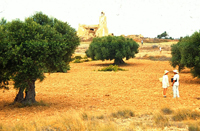
Between 1996 and 2000 joint team from the University of Pennsylvania, the American Academy in Rome, and the Institut National du Patrimoine conducted a survey of the Island of Jerba, under the direction of Dr. Renata Holod (History of Art; Curator, Near Eastern Section, University Museum), Dr. Elizabeth Fentress (Research Associate, Mediterranean Section, University Museum), and Dr. Ali Drine. The survey, carried out by transects running north-south across the island, revealed over 400 sites, giving a clear picture of the development of settlement between the fifth century B.C. and the 19th century. It revealed precocious agricultural settlement, fairly intensive trade with central Italy, and a strong presence of villas by the second century B.C.; a decline in sites in the fifth century; and a gradual strengthening of the settlement from the ninth century A.D. onward. This fairly coarse-grained image was further refined by intensive, gridded survey of the city-sites, Būrgū and Meninx, and of an 18th century estate, Gish’iyyīn; by geophysical survey at Meninx; and by excavation at a number of sites: the Punic and Roman city of Meninx, the late Roman fortlet at Tala, early mosques at Jami J Gmīr and Jami J Zāyid, and a medieval house at Jami J Zāyid. The publication is due in 2006 as a supplement to the Journal of Roman Studies.
The survey formed the basis of the dissertation of Thomas Morton (History of Art, Ph.D, 2003), who examined the forum of Meninx, on the southeastern coast of Jerba. The architecture was examined through the lens of Meninx's famed purple dye production, which made it one of the most prominent cities in Roman North Africa.
